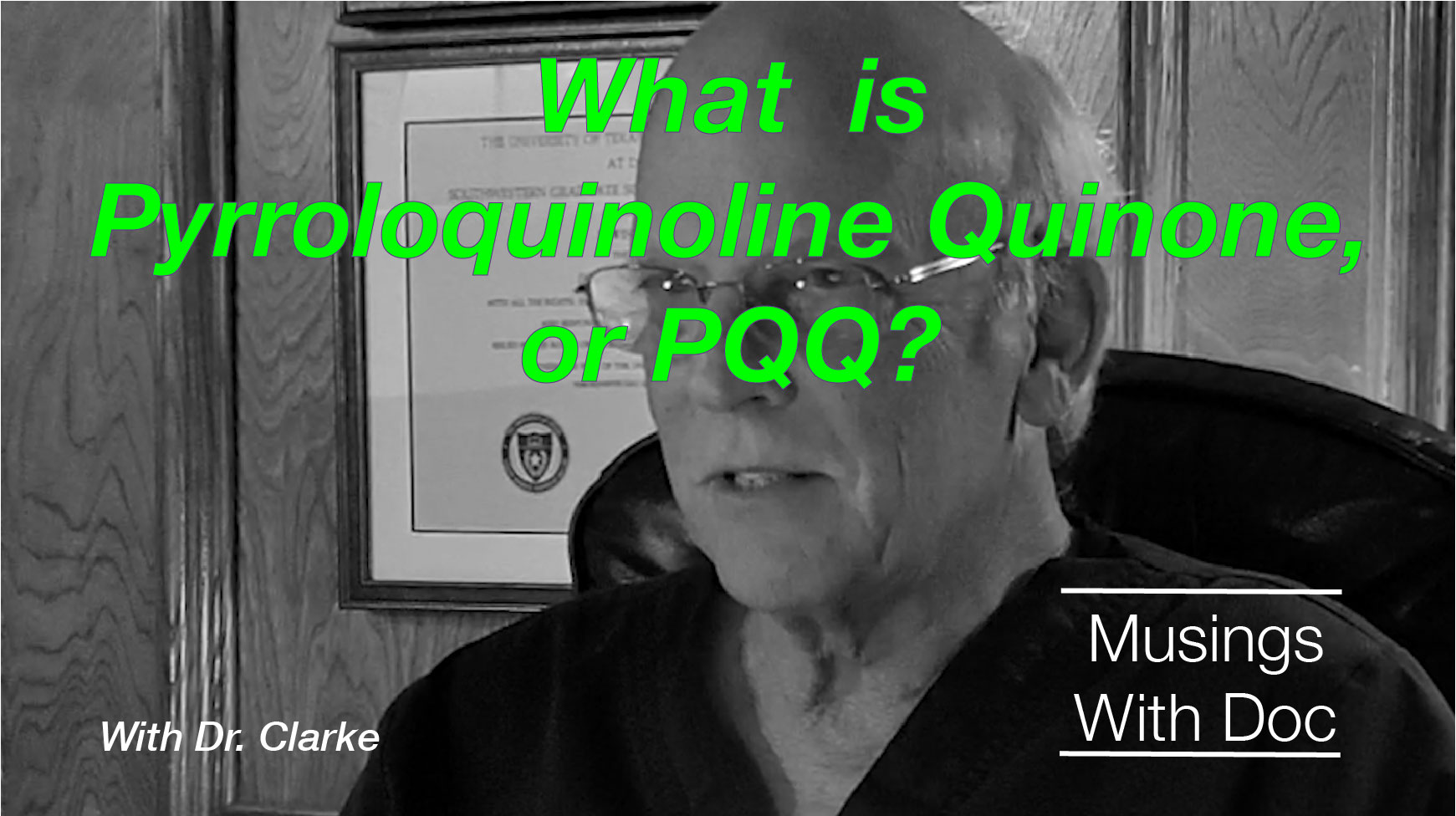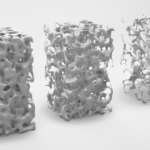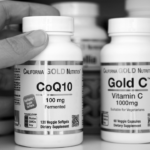
PQQ: The Benefits and Why Your Brain Cells Need It
Pyrroloquinoline quinone (PQQ) is receiving a lot of attention in the health and wellness spheres these days—and for good reason. Available in supplement form, this nutrient is one of the best-kept secrets in the nutritional supplement community. In this article, we’ll discuss everything you need to know about PQQ, why it’s in my neuro protocol, and why this supplement superstar is something you’ll want to add to your regimen.
What exactly is PQQ?
PQQ is a multi-functional nutrient that is commonly found in plant foods. It was first discovered in 1964 as a cofactor for enzymatic reactions in bacteria, in which it serves a similar function to that of B vitamins for humans.
When something is a “cofactor,” it means that it helps enzymes accomplish their jobs. There’s a class of these cofactor molecules that transfer electrons during reactions, which helps mitochondria produce energy. Other examples of cofactors that transfer electrons that you’ve probably heard of include, CoQ10, vitamin C, and glutathione.
PQQ is a natural compound that already exists in our cells. Found in high levels in human breast milk, PQQ is presumed to be a non-vitamin growth factor. The main source of PQQ in mammals, however, is dietary. It’s commonly found in leafy vegetables, fruits, and legumes, especially soy. It’s also found in soil and interstellar dust.
What does PQQ do and how does it work?
The health benefits of PQQ—which we’ll cover shortly—are all derived from three primary functions that it provides.
Antioxidant and anti-inflammatory action
PQQ is best known for its antioxidant activity. Antioxidants protect your cells from damage inflicted by harmful molecules called free radicals—a byproduct of inflammation. PQQ is an extremely potent antioxidant and is about 100 times more effective than vitamin C at eliminating free radicals. The antioxidant power of PQQ decreases inflammation and promotes the longevity of your heart, brain, liver, and other mitochondria-rich organs.
New mitochondrial growth
Mitochondria produce the vast majority of all cellular energy (ATP) and play an important role in our overall health. PQQ activates a key transcription factor protein (CREB) and directly stimulates mitochondrial biogenesis, which is the growth and replication of new mitochondria. Stronger mitochondria, and more of them, produce more cellular ATP. The more energy in a cell, the better it does its job. For example, more energy in your heart cells makes your heartbeat stronger, while more energy in your skin cells allows your skin to heal faster from wounds.
Nerve cells support
Nerve growth factor (NGF) is a small protein that plays a critical role in the growth, development, and maintenance of neurons. PQQ has been found to promote NGF production, with one study showing a 40-fold increase in NGF. Increased levels of NGF help to maintain the health of the brain and peripheral nerves and stimulate nerve regeneration.
What are the uses and benefits of PQQ?
As a powerful antioxidant, a stimulator of mitochondrial biogenesis, and a trigger of nerve growth factor production, PQQ offers a wide range of health benefits. Studies have shown that PQQ can provide:
Neurological support
PQQ offers many neuroprotective benefits for the following conditions:
Head injuries and strokes:
- Suppresses reactive nitrogen species, which spike in strokes and brain injuries. In this way, it provides protection against neuro-related injuries.
- Suppresses inflammatory cytokines.
- Binds up damaged cells and neurotoxins, such as glutamate, in your brain.
- Rescues hippocampal neurons.
- Decreases the size of the damaged area in strokes and traumatic brain injuries.
Alzheimer’s disease
- Blocks the damage of amyloid beta—the main component of the amyloid plaques found in the brains of people with Alzheimer’s disease. PQQ acts after amyloid beta has already accumulated, helping cells recover from amyloid beta-induced oxidant stress, preventing neuronal cell death, and decreasing further production of reactive oxygen species.
- Protects the brain against neurotoxicity induced by powerful toxins, such as mercury and oxidopamine, that are suspected to play a role in Alzheimer’s disease.
- Protects and rescues hippocampal memory cells.
Parkinson’s disease
- Increases a protein called DJ-1. This protein, which increases cell function and survival by combating intensive oxidative stress, is important for brain health and function. DJ-1 mutations have been linked to the onset of rare inherited forms of Parkinson’s disease and other neurological disorders.
- Protects the brain against neurotoxicity induced by powerful toxins, such as mercury and oxidopamine, that are suspected to play a role in Parkinson’s disease.
- Prevents the aggregation of alpha-synuclein proteins associated with Parkinson’s disease.
Dementia
- Prevents the aggregation of alpha-synuclein proteins associated with Lewy Body Dementia.
Heart support
PQQ improves blood circulation and cardiac function, supporting energy production in the heart and providing powerful antioxidant protection. It also offers the following benefits:
- Reduces the size of damaged areas in the heart from an acute heart attack.
- Protects against heart muscle dysfunction and reduces cellular damage.
- Helps heart muscle cells resist acute oxidative stress by preserving and enhancing mitochondrial function.
Joint support
Early research shows that PQQ has the potential to decelerate the deterioration of joints in rheumatoid arthritis and osteoarthritis, two of the major causes of joint pain in elderly people. In studies, PQQ was effective at suppressing cartilage-degrading enzymes and inflammatory markers in human cells and in laboratory mouse models.
Liver support
PQQ aids the liver with fat metabolism, breaking down more fat and converting it into greater energy output. Studies indicate that it may also reverse acute and chronic liver injury, including damage from fatty liver disease.
Skin support
PQQ can be effective as anti-aging prevention not just for your brain, heart, and liver, but also as a cosmetic anti-aging treatment for your skin. PQQ has been shown to rejuvenate skin cells and rebuild healthy tissue for thicker skin and fewer wrinkles. In fact, it’s a common ingredient in many anti-aging creams.
What is the recommended dosing for PQQ?
It’s important to note that the FDA has not approved PQQ for any medical purpose and, as such, studies haven’t been conducted to definitively determine a safe and effective dose for humans. That being said, clinical research has found benefits associated with the following doses:
- One study showed that about 20mg decreased inflammation in men of average weight.
- Other research suggests that results may be seen from doses as low as 5mg.
PQQ supplements are most commonly sold in 10mg, 20mg, and 40mg capsules. For new users, start at a dosage of 10mg per day. Monitor the effects and adjust the dosage accordingly over time.
Can I just get PPQ from foods?
PQQ naturally occurs in many foods, especially soy, spinach, green tea, green peppers, parsley, and kiwi. However, the PQQ content of even the most PQQ-rich foods is much lower than the amount you can get from a supplement (5mg to 40mg). Due to this, taking a supplement is a better option if you’re looking to reap PQQ’s benefits.
Should PQQ be taken with CoQ10?
Similar to PQQ, CoQ10 improves energy production at the cellular level. Taking CoQ10 with PQQ has a synergistic effect in modulating cellular signaling pathways, preventing damage from free radicals, and helping mitochondrial function.
CoQ10 and PQQ deliver a powerful one-two punch. CoQ10 works to improve the speed and efficiency of mitochondria, while PQQ assists by promoting the growth of mitochondria. Together they help the body produce more energy, faster. While more research needs to be conducted on the effects of this duo, studies conducted separately on each supplement show that they both have distinct benefits to cellular energy production, heart health, and brain health.
Does PQQ have any side effects?
While more research needs to be done in relation to PQQ’s safety and side effects, early research has not observed any adverse effects when taking the recommended dosage on packaging. One study found that a week’s consumption of up to 0.3mg/kg (20mg for a 154-pound male) did not produce any adverse side effects.
Toxicology studies in rats, however, indicate a risk of kidney damage when PQQ is taken at very high doses. As such, it’s recommended to not take more than is recommended on your supplement’s packaging.
Anecdotally, some people have reported mild headaches and insomnia. In these cases, the person likely either took too much or is very sensitive to supplements.
Why I use PQQ in my neuro protocol
I personally take PQQ as part of my neuro protocol. Why? Here are my top reasons:
To protect cells. PQQ protects cells in the body from oxidative damage and supports the metabolism of energy and healthy aging.
To protect the brain. By improving brain energy metabolism, PQQ can help protect against cognitive decline, stroke, excitotoxicity, and the neuronal damage caused by high blood sugar. PQQ encourages the brain to operate at its highest potential while optimizing the regenerative process and scavenging damaged cells.
To stimulate new neuronal growth. PQQ stimulates nerve growth factor (NGF), a key protein involved in the growth and survival of neurons. So, PQQ not only stops neuronal damage, but also stimulates new neuronal growth.
To support mitochondria. PQQ supports optimal mitochondrial function. It’s been shown to reduce mitochondrial oxidative stress, as well as stimulate mitochondrial biogenesis. Mitochondria are the cells’ energy producers and the more mitochondria we have, the more energy our cells can make. The decay of mitochondria in brain cells is a primary cause of all neurodegenerative disorders, from Parkinson’s to dementia.
The bottom line
PQQ is a lesser-known supplement that is making a big splash in the wellness world. Adding PQQ to your supplement protocol is a powerful way to support the health of your whole body. It offers a wide range of benefits for the brain and body, including stimulating mitochondria biogenesis, producing nerve growth factor, providing powerful antioxidant activity, reducing inflammation, and reducing oxidative stress.
It’s important to note that the vast majority of studies involving PQQ were conducted using animals. Further studies involving humans are needed to better understand its role in human health. However, I think researchers would agree that the animal studies to date are very intriguing and exciting. With very few side effects reported and tons of promising data, adding PQQ to your regimen and seeing how it works for you is a worthy investment and it is why it is a mainstay in my neuro protocol.
References:
https://pubmed.ncbi.nlm.nih.gov/14257587/
https://www.sciencedirect.com/science/article/pii/B9780128144664000136
https://pubmed.ncbi.nlm.nih.gov/1702437/
https://www.ncbi.nlm.nih.gov/pmc/articles/PMC2804159/
https://www.tandfonline.com/doi/pdf/10.1271/bbb.57.1231
https://pubmed.ncbi.nlm.nih.gov/19026989/
https://pubmed.ncbi.nlm.nih.gov/32073012/
https://www.sciencedirect.com/science/article/abs/pii/S0736574815000167
https://pubmed.ncbi.nlm.nih.gov/22843070/
https://pubmed.ncbi.nlm.nih.gov/16709402/
https://www.ncbi.nlm.nih.gov/pmc/articles/PMC2850417/
https://pubmed.ncbi.nlm.nih.gov/19191107/
https://www.ncbi.nlm.nih.gov/pmc/articles/PMC5995849/
https://pubmed.ncbi.nlm.nih.gov/18591768/
https://jnnp.bmj.com/content/75/1/144
https://pubmed.ncbi.nlm.nih.gov/19191107/
https://pubmed.ncbi.nlm.nih.gov/16962995/
https://pubmed.ncbi.nlm.nih.gov/16962995/
https://pubmed.ncbi.nlm.nih.gov/15770429/
https://pubmed.ncbi.nlm.nih.gov/16891289/
https://www.ncbi.nlm.nih.gov/pmc/articles/PMC2844438/
https://pubmed.ncbi.nlm.nih.gov/26319019/
https://pubmed.ncbi.nlm.nih.gov/25687637/
https://pubmed.ncbi.nlm.nih.gov/33535680/
https://www.ncbi.nlm.nih.gov/pmc/articles/PMC4379100/
https://pubmed.ncbi.nlm.nih.gov/24231099/
https://www.sciencedirect.com/science/article/pii/B9780444525123000711
https://pubmed.ncbi.nlm.nih.gov/24231099/
https://pubmed.ncbi.nlm.nih.gov/24995591/
https://pubmed.ncbi.nlm.nih.gov/18591768/
https://www.ncbi.nlm.nih.gov/pmc/articles/PMC4220070/
https://pubmed.ncbi.nlm.nih.gov/7764070/

